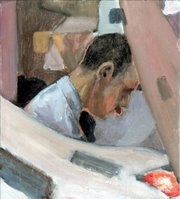
Since we've touched on the subject of black oil paint in the comments on the last post, I thought this was a good opportunity to side-step into these little paintings.

I make no great claims for them as works of art, but they were all produced using what I've always known as "the Matisse palette" - white (titanium in this case), ivory black, vermilion, and yellow ochre.

You'll see there's no blue on the palette. This means that to make green you have to use black and yellow, to make purple you have to use black and white with a bit of vermilion. To approximate blue, you can only really use black and white, which gives grey, of course.
The trick - and I admit that when I painted these I hadn't mastered it - is to influence the grey by simultaneous contrast. If you surround the grey with orange, you'll make the grey take on a bluish cast. Similarly, the purple can be made more purple by putting it next to yellow.

I've no idea whether Matisse ever actually used this palette. If he did, I guess he'd have used the colours in rather discrete flat areas. But I found it interesting to use them for more modelled forms, like Torquil's head in the picture above.
The peculiar orange rim round his head is due to the orange lamp he was sitting in front of. All of these were done inside an environment constructed from torn and draped newspaper, lit by coloured lamps. So they're not abstracts in the strict sense. Felt you should know that.











